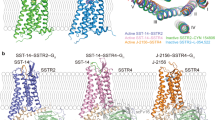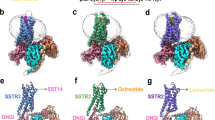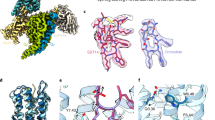Abstract
Four linear β2/β3-di- and α/β3-tetrapeptides (1–4) were investigated as somatostatin sst4 receptor agonists on recombinant human and mouse somatostatin receptors. Human somatostatin receptor subtypes 1–5 (sst1–5), and mouse somatostatin receptor subtypes 1,3,4 and 5, were characterised using the agonist radioligands [125I]LTT-SRIF-28, [125I][Tyr10]CST14 and [125I]CGP 23996 in stably transfected Chinese hamster lung fibroblast (CCL39) cells. The peptides bound selectively to sst4 receptors with nanomolar affinity (pKd=5.4–7.8). The peptides were investigated on second messenger systems both as agonists, and as antagonists to SRIF-14-mediated effects in CCL39 cells expressing mouse sst4 receptors, via measurement of inhibition of forskolin-stimulated adenylate cyclase activity, and stimulation of luciferase expression. The peptides showed full agonism or pronounced partial agonism (40 to 100% relative intrinsic activity) in both inhibition of forskolin-stimulated adenylate cyclase activity (pEC50=5.5–6.8), and luciferase expression (pEC50=5.5–6.5). The agonist potential was confirmed since antagonism was very difficult to establish. The data show that β2/β3-di- and α/β3-tetrapeptide derivatives have agonist potential at recombinant somatostatin sst4 receptors. Therefore, they may be used to elucidate physiological and biochemical effects mediated by sst4, and may also have potential as therapeutic agents.



Similar content being viewed by others
References
Arvidsson PI, Frackenpohl J, Ryder NS, Liechty B, Petersen F, Zimmermann H, Camenisch GP, Woessner R, Seebach D (2001) On the antimicrobial and hemolytic activities of amphiphilic β-peptides. Chem Biochem 2:771–773
Brazeau P, Vale W, Burgus R, Ling N, Butcher M, Rivier J, Guillemin R (1973) Hypothalamic polypeptide that inhibits the secretion of immunoreactive pituitary growth hormone. Science 179:77–79
Cheng RP, Gellman SH, DeGrado WF (2001) β-peptides: from structure to function. Chem Rev 101:3219–3232
De Lean A (1979) SCTFIT: a computer program for simultaneous analysis of saturation and competition curves. Howard Hughes Medical Institute, Duke University Medical Center, Durham, North Carolina
Epelbaum J, Dournaud P, Fodor M, Viollet C (1994) The neurobiology of somatostatin. Crit Rev Neurobiol 8:25–44
Frackenpohl J, Arvidsson PI, Schreiber JV, Seebach D (2001) The outstanding biological stability of β- and γ-peptides toward proteolytic enzymes: an in vitro investigation with fifteen peptidases. Chem Biochem 2:445–455
Gademann K, Seebach D (2001) Synthesis of cyclo-β-tripeptides and their biological in vitro evaluation as antiproliferatives against the growth of human cancer cell lines. Helv Chim Acta 84:2924–2937
Gademann K, Hintermann T, Schreiber JV (1999a) β-peptides: twisting and turning. Curr Med Chem 6:905–925
Gademann K, Ernst M, Hoyer D, Seebach D (1999b) Synthesis and biological evaluation of a cyclo-β-tetrapeptide as a somatostatin analogue. Angew Chem Int Ed (English) 38:1223–1226
Gademann K, Ernst M, Seebach D, Hoyer D (2000) The cyclo-β-tetrapeptide (β-Hphe-β-HThr-β-HLys-β-HTrp): synthesis, NMR structure in methanol solution, and affinity for human somatostatin receptors. Helv Chim Acta 83:16–33
Gademann K, Kimmerlin T, Hoyer D, Seebach D (2001) Peptide folding induces high and selective affinity of a linear and small β-peptide to the human somatostatin receptor 4. J Med Chem 44:2460–2468
Guibourdenche C, Podlech J, Seebach D (1996) Selective acylations of multifunctional nucleophiles, including carbohydrates and nucleosides, with intermediates generated by Wolff rearrangement of amino acid derived diazo ketones: preparation of β-amino acid derivatives. Liebigs Annal 7:1121–1129
Guichard G, Abele S, Seebach D (1998) Preparation of N-Fmoc-protected β2- and β3- amino acids and their use as building blocks for the solid-phase synthesis of β-peptides. Helv Chim Acta 81:187–206
Hamuro Y, Schneider JP, DeGrado WF (1999) De novo design of antibacterial β-peptides. J Am Chem Soc 121:12200–12201
Hannon JP, Nunn C, Stolz B, Bruns C, Weckbecker G, Lewis I, Troxler T, Hurth K, Hoyer D (2002) Drug design at peptide receptors: somatostatin receptor ligands. J Mol Neurosci 18:15–27
Hill DJ, Mio MJ, Prince RB, Hughes TS, Moore JS (2001) A field guide to foldamers. Chem Rev 101:3893–4012
Hoyer D, Luebbert H, Bruns C (1994) Molecular pharmacology of somatostatin receptors. Naunyn-Schmiedebergs Arch Pharmacol 350:441–453
Hoyer D, Bell GI, Berelowitz M, Epelbaum J, Feniuk W, Humphrey PPA, O'Carroll AM, Patel YC, Schonbrunn A, Taylor JE, Reisine T (1995) Classification and nomenclature of somatostatin receptors. Trends Pharmacol Sci 16:86–88
Krulich L, Dhariwal AP, McCann SM (1968) Stimulatory and inhibitory effects of purified hypothalamic extracts on growth hormone release from rat pituitary in vitro. Endocrinology 83:783–790
Martin JL, Chesselet MF, Raynor K, Gonzales C, Reisine T (1991) Differential distribution of somatostatin receptor subtypes in rat brain revealed by newly developed somatostatin analogs. Neuroscience 41:581–593
Micuch P, Seebach D (2002) Preparation of β2-homotryptophan derivatives for β-peptide synthesis. Helv Chim Acta 85:1567–1577
Patel YC (1997) Molecular pharmacology of somatostatin receptor subtypes. J Endocrinol Invest 20:348–367
Patel YC (1999) Somatostatin and its receptor family. Front Neuroendocrinol 20:157–198
Podlech J, Seebach D (1995) The Arndt-Eistert-reaction in peptide chemistry. A facile access to homopeptides. Angew Chem 107:507–509/Angew Chem Int Ed (English) 34:471–472
Raynor K, Reisine T (1989) Analogs of somatostatin selectively label distinct subtypes of somatostatin receptors in rat brain. J Pharmacol Exp Ther 251:510–517
Raynor K, Coy DC, Reisine T (1992) Analogs of somatostatin bind selectively to brain somatostatin receptor subtypes. J Neurochem 59:1241–1250
Reubi JC (1984) Evidence for two somatostatin-14 receptor types in rat brain cortex. Neurosci Lett 49:259–263
Rohrer SP, Berk SC (1999) Development of somatostatin receptor subtype selective agonists through combinatorial chemistry. Curr Opin Drug Discov Dev 2:293–303
Rohrer SP, Schaeffer JM (2000) Identification and characterization of subtype selective somatostatin receptor agonists. J Physiol Paris 94:211–215
Rohrer SP, Birzin ET, Mosley RT, Berk SC, Hutchins SM, Shen DM, Xiong Y, Hayes EC, Parmar RM, Foor F, Mitra SW, Degrado SJ, Shu M, Klopp JM, Cai SJ, Blake A, Chan WWS, Pasternak A, Yang L, Patchett AA, Smith RG, Chapman KT, Schaeffer JM (1998) Rapid identification of subtype-selective agonists of the somatostatin receptor through combinatorial chemistry. Science 282:737–740
Rueping M, Mahajan Y, Sauer M, Seebach D (2002) Cellular uptake studies with β-peptides. Chem Biochem 3:257–259
Schindler M, Kidd EJ, Carruthers AM, Wyatt MA, Jarvie EM, Sellers LA, Feniuk W, Humphrey PPA (1998) Molecular cloning and functional characterization of a rat somatostatin sst2b receptor splice variant. Br J Pharmacol 125:209–217
Seebach D, Matthews JL (1997) β-peptides: a surprise at every turn. Chem Commun 2:2015–2022
Seebach D, Overhand M, Kühnle FNM, Martinoni B, Oberer L, Hommel U, Widmer H (1996) β-peptides: synthesis by Arndt-Eistert homologation with concomitant peptide coupling. Structure determination by NMR and CD spectroscopy and by X-ray crystallography. Helical secondary structure of a β-hexapeptide in solution and its stability towards pepsin. Helv Chim Acta 79:913–941
Seebach D, Abele S, Schreiber JV, Martinoni B, Nussbaum AK, Schild H, Schultz H, Henneke H, Woessner R, Bitsch F (1998) Biological and pharmacokinetic studies with β-peptides. Chimia 52:734–739
Seebach D, Abele S, Gademann K, Jaun B (1999) Pleated sheets and turns of β-peptides with proteinogenic side chains. Angew Chem 111:1700–1703/Angew Chem Int Ed (English) 38:1595–1597
Seebach D, Rueping M, Arvidsson PI, Kimmerlin T, Micuch P, Noti C, Langenegger D, Hoyer D (2001a) Linear, peptidase-resistant β2/β3-di- and α/β3-tetrapeptide derivatives with nanomolar affinities to a human somatostatin receptor. Helv Chem Acta 84:3503–3510
Seebach D, Albert M, Arvidsson PI, Rueping M, Schreiber JV (2001b) From the biopolymer PHB to biological investigations of unnatural β- and γ-peptides. Chimia 55:345–353
Siehler S, Seuwen K, Hoyer D (1999) Characterisation of human recombinant somatostatin receptors. I. Radioligand binding studies. Naunyn-Schmiedebergs Arch Pharmacol 360:488–499
Tran VT, Beal MF, Martin JB (1985) Two types of somatostatin receptors differentiated by cyclic somatostatin analogs. Science 228:492–495
Umezawa N, Gelman MA, Haigis MC, Raines RT, Gellman SH (2002) Translocation of a β-peptide across cell membranes. J Am Chem Soc 124:368–369
Vanetti M, Kouba M, Wang XM, Vogt G, Hoellt V (1992) Cloning and expression of a novel mouse somatostatin receptor (SSTR2B). FEBS Lett 311:290–294
Werder M, Hauser H, Abele S, Seebach D (1999) β-peptides as inhibitors of small-intestinal cholesterol and fat absorption. Helv Chim Acta 82:1774–1783
Wiegand H, Wirz B, Schweizer A, Camenisch GP, Rodriguez Perez MI, Gross G, Woessner R, Voges R, Arvidsson PI, Frackenpohl J, Seebach D (2002) The outstanding metabolic stability of a 14C-Labeled β-nonapeptide in rats—in vitro and in vivo pharmacokinetic studies. Biopharm Drug Dispos (in press)
Yang L, Berk SC, Rohrer SP, Mosley RT, Arison BH, Birzin ET, Hayes EC, Mitra SW, Parmar RM, Cheng K, Wu TJ, Butler BS, Foor F, Pasternak A, Pan R, Silva M, Freidinger RM, Smith RG, Chapman K, Schaeffer JM, Patchett AA (1998) Synthesis and biological activities of potent peptidomimetics selective for somatostatin receptor subtype 2. Proc Natl Acad Sci USA 95:10836–10841
Zhou C, Guo G, Morriello G, Pasternak A, Pan Y, Rohrer SP, Birzin ET, Huskey S-EW, Jacks T, Schleim KD, Cheng K, Schaeffer JM, Patchett AA, Yang L (2001) Nipecotic and iso-nipecotic amides as potent and selective somatostatin subtype-2 receptor agonists. Bioorg Med Chem Letts 11:415–417
Acknowledgements
DH and CN were supported by EC Contract QLG3-CT-1999-0908 and Swiss grant BBW 00-0427.
Author information
Authors and Affiliations
Corresponding author
Rights and permissions
About this article
Cite this article
Nunn, C., Rueping, M., Langenegger, D. et al. β2/β3-di- and α/β3-tetrapeptide derivatives as potent agonists at somatostatin sst4 receptors. Naunyn-Schmiedeberg's Arch Pharmacol 367, 95–103 (2003). https://doi.org/10.1007/s00210-002-0673-4
Received:
Accepted:
Published:
Issue Date:
DOI: https://doi.org/10.1007/s00210-002-0673-4




